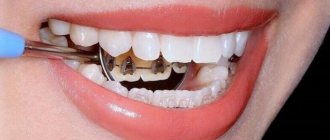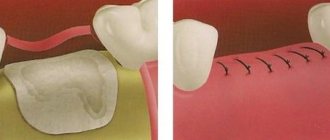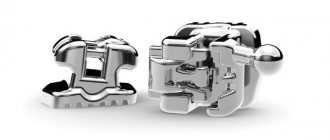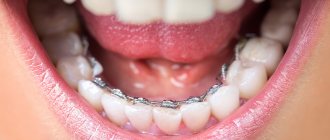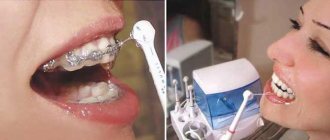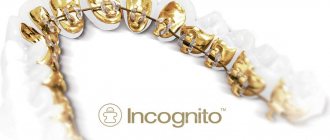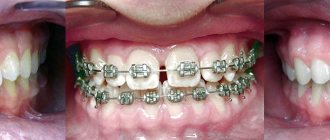Procedure for installing braces
How braces are installed, whether it hurts or not, how long the procedure takes - most often these are the questions that concern those who decide to fix their smile. Orthodontists remind dental-phobic patients that beauty sometimes requires sacrifice, so you will have to be patient a little.
Also, be patient. Installing a brace system on the upper and lower jaw is not a quick task; you will need to sit with your mouth open for 1.5 - 2 hours. This is precisely what worries patients the most, and not the fact that it will hurt. An orthodontist’s work is responsible and he doesn’t like to rush. Get distracted and your new smile may be at risk. An error of even 1 mm is critical! One by one, the doctor glues brackets to the teeth, which are then connected with a metal arch. This is a guide for crooked teeth, it shows the place to which they should move. Don’t believe those who say that installing braces is very painful. The stage is responsible, but painless.
Contraindications for installing braces
- If there are problems with the gums, installation of a braces system is possible only in the absence of an inflammatory process.
- Caries is also considered a temporary limitation for the fixation of orthodontic appliances.
- Poor oral hygiene is a serious barrier to starting treatment. If a person doesn’t brush his teeth well, then braces will only make the situation worse.
- An increased tendency to caries, coupled with poor hygiene, is a contraindication to fixing braces.
How to remove the system (with video)
Before starting work on removing the structure from the teeth, the doctor installs a special pad in the patient’s mouth, which will not allow his jaws to close spontaneously. After this, using special tweezers, the device holding the arch, which serves as a support for the braces, is removed.
When the arch is removed from the oral cavity, it is time to remove the locks. They are removed with orthodontic tweezers. At this stage, the patient may feel that his teeth are loose. This feeling is caused by the weakening of the usual pressure of the braces system. In fact, after its removal, everything will quickly return to normal, and the unpleasant sensations will disappear.
As for the time required to free the structure, its duration directly depends on the type of installed system. It takes a little longer to remove lingual braces, that is, those installed on the inside, since they are more difficult to get to. Removing ceramic and sapphire models also takes more time, because they fit much more tightly to the teeth. And their locks leave a lot of fragments that require careful removal.
In general, the procedure takes from 15 to 40 minutes and does not require prior anesthesia.
It can only be done in a clinic, because it is simply impossible to remove braces at home without damaging the teeth, so you should not get rid of the braces yourself.
When the system is completely disassembled, a careful examination of the teeth is carried out. On many of them there are traces of glue that held some structural elements together. Remains of glue are removed using a special grinding attachment - a finisher. This attachment allows you to clean the tooth from glue without damaging its enamel. If plaque has formed on the teeth, ultrasonic cleaning can be performed, and, if the patient wishes, whitening can be performed.
Stages of installing braces on teeth
There are two ways to place braces: direct and indirect. The first is considered a classic and widespread. The indirect method of fixing the bracket system is more progressive, but is still considered new. So far, not all clinics use this method.
Direct method
If braces are installed using the direct method, the orthodontist glues one clasp to each tooth, that is, installs them individually. It is impossible to make a mistake, so the doctor checks his actions with panoramic photographs. This work can be compared to jewelry; accuracy of up to 1 mm is important here. Today this is the most common method of installing braces.
The process of installing braces using the direct method
- An expander is installed in the mouth, with which the orthodontist can clearly see all the teeth.
- The tooth surface is polished and dried with a stream of air.
- First, braces are installed on the upper jaw. Locks are glued to the teeth, and dental cement is first applied to them. Then the cement residues are removed, and the solution hardens under ultraviolet light. Installation of braces on the lower jaw can be carried out immediately or after 1 – 8 months, depending on the indications.
- The mouth is freed from the expander, and arches are installed in the braces.
Indirect method
In this case, an accurate plaster model of the teeth is made where the clasps are placed. All this is transferred to a mouthguard, which is placed on the dentition. In this way the entire system is fixed at the same time. Very convenient: the installation time for braces is reduced to an average of 30 minutes, and the design details are installed more accurately. It is clear that the future lies with this technique.
Stages of installing braces using the indirect method
- A plaster cast of the jaw is first taken.
- A plaster model of the dentition is created.
- Locks are installed on the plaster model and connected with an arc.
- The finished structure is fixed on the teeth.
Installing lingual braces on the inner surface of teeth requires highly qualified orthodontist.
Does it hurt to put
Some people are afraid to get braces because of the possible pain. But the process of installing braces on your teeth is completely painless. Braces are attached using glue to the enamel of the teeth. The enamel does not contain nerve endings, so toothache cannot occur.
The braces procedure takes about two hours, so opening your mouth for a long period of time can lead to discomfort. To do this, a mouth opener is installed, which itself holds the mouth open, while saliva can be swallowed or it can be collected with a saliva ejector.
Features of installing braces in adults, adolescents and children
Installing braces for a teenager is not much different from installing braces for an adult.
Correcting the bite in children simply happens faster. The need for treatment with braces and the appropriate age will be determined by the orthodontist. For a teenager, the cost of braces in Moscow depends on the clinic and the chosen design. Braces are not used on baby teeth. If they are placed too early, the child may be left without teeth. To install braces, you will have to wait at least 10 to 12 years until your teeth change. The age after 14 years is optimal for using braces. Treatment occurs faster than in adults and is easier to tolerate.
Parents often doubt whether teenagers should get braces. Crooked teeth can lead to health problems over time. Incorrect positioning of teeth provokes the development of caries, periodontitis, and digestive problems.
What determines the length of time you wear braces?
The duration of orthodontic treatment depends on several factors.
- age
. You can correct your bite with braces at any age, but in teenagers, teeth move much faster, so treatment will take much less time than, say, a thirty-five-year-old patient with a similar diagnosis. - Complexity of the clinical case
. - Type of bracket system
. Non-ligature metal braces show excellent results in a short time, unlike sapphire and ceramic braces. Treatment with lingual braces lasts longer than with regular braces. - Compliance with doctor's recommendations
. If used incorrectly or if the structure is damaged, the effectiveness of treatment may decrease and the time frame may increase.
What should you do before installing braces?
- Pictures before installing braces.
At the initial appointment, before installing braces, the doctor will conduct an examination and draw up a preliminary treatment plan. To clarify, you will need to take x-rays and casts.
- Impressions before installing braces.
They are done only if it is planned to fix the system using an indirect method.
- Sanitation of the oral cavity.
The main rule is that braces are installed only on healthy teeth. All problems must be resolved before the responsible moment. Maintaining oral hygiene with braces will become more difficult; unattended caries will definitely take advantage of this. Individual braces will have to be removed; treatment will be difficult and expensive. Of course, caries can appear after installing braces on your teeth. In this case, treatment cannot be postponed until later.
- Cleaning before installing braces.
Teeth should not only be healthy, but also clean. At least one day, or better yet several days before, teeth are cleaned before installing braces.
How the system works
After installing the system, it begins to affect the ligaments surrounding the tooth socket. The body tries to maintain the same balance, so it tries to maintain the volume of connecting fibers. In the area where the ligaments are sharply compressed, the bone tissue of the jaw begins the process of resorption. This results in additional space being created between the teeth for them to move.
In the area where the fibers begin to stretch, new bone tissue is formed. It prevents the tooth from returning to its original position. The main advantage of the operating principle of braces is that the result obtained is maintained throughout the patient’s life, so the design can be installed at any age. Its device allows you to change any pathology.
In patients, braces affect the teeth for a long time, since the bone unit moves only 1 mm a month after installation. Applying more pressure will shorten this period. The orthodontist calculates the strength of the system and must independently tighten the arch and brackets. Otherwise, nerve endings and blood vessels are damaged, which disrupts the functioning of the circulatory system and causes diseases of the oral cavity. In addition to the fact that the patient will experience constant pain, the entire principle of operation of braces is disrupted.
It is not braces that correct the position of teeth. The arc corrects, it serves as a link of communication and brings units together where necessary. It is she who moves the teeth in the right direction. In order for the entire structure to be strong, it is necessary to periodically replace a weakened arc with a stronger one. The lock is fixed using a special composite in the center of the tooth, and each unit has an individual bracket.
You cannot use brackets designed for incisors to a molar, as it will never take the required position. After all, each lock has a certain angle of inclination set for one tooth. The orthodontist fixes the arch in a certain shape, which guarantees the elimination of row pathology. While using the system, dental braces work by tightening the wire and bringing its parts together - locks and rods.
First, a thin elastic arch is installed, which gently affects the teeth. As soon as they get used to constant pressure, it is replaced with a thicker one. The tooth moves, weakens the bone tissue, so its new formations appear to fix the tooth in a new position. This process can be called bone remodeling.
Bite problems begin due to thinning of the bone plates or a decrease in their size and density. The speed and effectiveness of treatment for patients may vary, since orthodontic mechanics and the form of pathology or atrophy are different. Despite the general principle of operation of braces, the reaction to correcting the bite is not always effective.
Adaptation after installation of braces
The first days after installing braces are the most difficult. May have problems.
- Teeth hurt after installing braces.
- The mucous membrane is irritated.
- Diction has worsened.
- Difficulty chewing food.
- Braces interfere with the tongue.
All of the above is a natural reaction of the body to foreign objects. Teeth begin to move in the right direction immediately after treatment begins. It's painful, you'll have to be patient for a while. After installing braces, how much your teeth hurt is the most common question for an orthodontist. If he calculated everything correctly, after a few days the discomfort will decrease. If you can't stand it, take a painkiller. Continuous unbearable pain is a reason for an immediate visit to the doctor.
Pain after installing braces can be caused by irritation of the mucous membrane, in this case orthodontic wax will help. If there is strong pressure from the staples on soft tissue, rinse your mouth with a solution of 1 teaspoon of regular salt per glass of warm water. It is better to treat wounds in the oral cavity with disinfectants.
Gradually, the teeth will change their incorrect position, and the orthodontist will change the metal arch. After this, pain may appear again for a few days, but not as severe as on the first day after installing braces.
Duration of treatment with braces
The time for wearing braces is determined by the orthodontist, and this period is purely individual for each patient. It can range from a couple of months to several years. Exactly how long you should walk with dental braces depends on many factors. These include:
- Patient's age. The larger it is, the longer it takes to straighten the bite.
- Nature of the problem. If you need to correct minor flaws, you won’t need to spend a lot of time with braces. In particularly difficult cases, the wearing period increases significantly.
- Compliance with medical recommendations. While wearing braces, the patient must follow established rules for maintaining oral hygiene procedures and regularly visit his doctor to adjust the design. If visits to the doctor are often postponed, treatment progresses more slowly, and therefore it will take longer to wear braces.
These pliers are used to remove each bracket.
It doesn’t hurt at all, the enamel is not damaged To prevent teeth from moving apart after braces, you cannot remove the structure before the time specified by the doctor. This will lead to the fact that all the efforts spent on bringing the bite back to normal will be wasted, so you should think carefully before deciding to take such a step. You can get rid of braces ahead of schedule only in the following cases:
- an allergic reaction of the body to the materials from which the structure is made;
- complete lack of positive dynamics of treatment;
- the need for surgical intervention in the oral cavity.
Caring for braces after installation
Caring for braces after installation is more difficult than caring for teeth without them. There are more hard-to-reach places in the mouth to clean, and plaque forms faster. It is necessary to responsibly follow all the doctor’s recommendations so that later, after straightening, you do not have to put fillings on all your teeth. You will need an orthodontic brush, brush, dental floss and irrigator.
How to care for braces after installation?
- Teeth with braces must be brushed 3–4 times a day, slowly and thoroughly, ideally for 10–15 minutes. It is recommended to use a special orthodontic brush: you can recognize it by the inscription Orthodontic or Ortho. You will also need a brush to help clean your teeth around the braces. Dental floss can handle even the smallest food debris. An irrigator - a device that can clean the most inaccessible places - completes the care.
- Sticky food is a no-no as it can get stuck under your braces. It is better to postpone sweets, especially toffees, until after treatment, as well as foods and drinks high in sugar and acids.
- Sapphire, ceramic and plastic braces require an expanded list of limited products. Drinks containing high amounts of dyes—tea, coffee, soda, and some juices—can affect the color of your orthodontic system.
- In the first days after installing braces, it is not recommended to eat solid food. As for small children, everything should be pureed and liquid. This even applies to fruits. Anything that needs to be chewed is excluded. You can use meat, but be careful not to get stuck in the fibers. It is better to choose tender varieties and cut into small pieces.
If it is not possible to brush your teeth after eating, you should at least rinse your mouth. Even if you care for your braces according to all the rules, periodically undergo professional cleaning and rinse your mouth with a fluoride solution.
Is it possible to whiten teeth after braces?
The picture that opens after removing the staples does not always look as rosy as the patient would like. When braces are placed on the teeth for a long time, the areas of the tooth surface covered by them retain their shade, but the surrounding enamel may change color. How noticeable will the difference be? This depends on several factors:
- on the individual characteristics of the organism;
- on the number of cigarettes smoked and the frequency of consumption of food and drinks with dyes;
- on the quality of hygiene procedures during treatment.
Since the bite after braces has already become ideal, everyone wants to quickly get rid of the unpleasant contrast. But professional teeth whitening cannot be carried out at this moment. The enamel under braces must be restored and strengthened, otherwise the effect of chemicals will be destructive to it. But your doctor may recommend brushing your teeth with AirFlow: the gentle action of water mixed with an abrasive will remove plaque and lighten darkened areas.
How to install braces inexpensively?
Of course, everyone wants to have beautiful, straight teeth. But in the pursuit of the perfect smile, not the least important question is where the installation of braces in Moscow is inexpensive. The compulsory medical insurance policy does not include bite correction and teeth straightening, which means you have to pay for them. Orphans, disabled children, and children with congenital jaw pathologies have the right to preferential treatment. Free installation of braces in the clinic is provided for patients injured due to medical errors.
You can use tricks and look for great deals at dental clinics. Often, braces are offered as a gift during orthodontic treatment. There are also gifts from trial batches of new products. Many clinics actively use savings systems. The bonuses accumulated over the year may well be enough to pay for braces. The most profitable offers are in the turnkey format.
It is immediately clear how much you will have to spend, and in the future - to avoid mark-ups.
However, be prepared for serious financial costs. Orthodontic treatment is not quick; it takes from 1 to 2.5 years to correct a bite. The most economical braces are metal, from 15,000 rubles. Ceramic models will cost more - from 35,000 rubles and sapphire - from 40,000 rubles. For invisible lingual braces you will have to pay significantly more than for vestibular models - from 100,000 rubles. All prices are for installing braces on one jaw.
.
What to do after removal
Those who have not experienced bite correction for some reason think that when braces are removed, the treatment process ends and they can show everyone a perfect smile. But everything is not so simple, because after getting rid of one structure, you will have to install another, and before that, undergo a course of remineralization of tooth enamel, and, if necessary, treat caries.
During prolonged wearing of braces, white spots may form on areas of tooth enamel that were covered by structural elements. They are foci of demineralization. Such lesions appear due to errors in dental care or because the enamel was weak to begin with.
The stains after removing the system look something like this:
Remineralizing therapy will help save the situation. It consists of treating the tooth with special compounds that saturate the enamel with calcium and fluoride. The drugs are applied using applications to the affected areas and act not only during application, but also after the procedure. After this, the enamel will be like new.
To strengthen tooth enamel, you can additionally drink a vitamin complex (for example, Asepta or Vitrum), which contains substances that have a positive effect on hard dental tissues. This will help your teeth recover faster after the braces are removed.
In some cases, before moving on to consolidating the results achieved with braces, it is necessary to treat the resulting caries and restore damaged teeth. Only after this can you move on to the next stage of treatment and is called retention.
